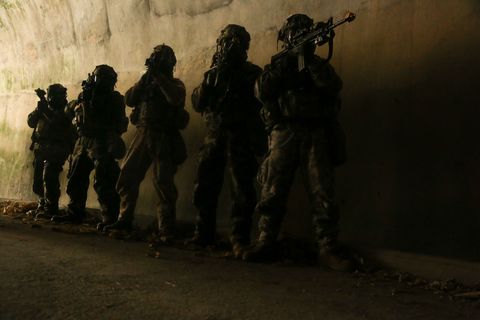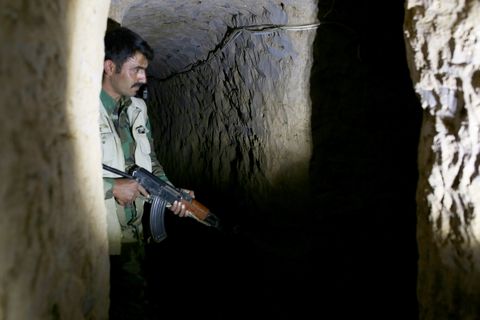by Kyle Mizokami
Trump claims the raid unfolded too quickly for the robot to be deployed.
The U.S. military is conducting extensive research into operating drones in caves and tunnels, and yes, there probably was a robot present.
President Donald Trump claims that U.S. forces brought a “robot” with them when they raided the hideout of Islamic State leader Abu Bakr al-Baghdadi. At least one outlet has cast doubt on the claim, but the claim is likely true. The U.S. Military has invested considerable time and effort in both subterranean warfare and robotics, and a robot designed to scout tunnel complexes would very likely be brought along on a mission to capture a high value target.
We actually had a robot to go in the tunnel but we didn’t get it because we were tracking him very closely. But we had a robot just in case because we were afraid he had a suicide vest on and if you get close to him and he blows it up, you’re going to die.
The President also said:
The robot was set to but we didn’t hook it up because we were too — they were moving too fast. We were moving fast. We weren’t 100 percent sure about the tunnel being dead ended. It’s possible that there could have been an escape hatch somewhere along that we didn’t know about.
 In an article about the President’s claim, Interesting Engineering says, “so, was there really a robot? It is hard to tell. Some have speculated that it may have been a drone and that the president was simply confused.”
In an article about the President’s claim, Interesting Engineering says, “so, was there really a robot? It is hard to tell. Some have speculated that it may have been a drone and that the president was simply confused.”
Chip SomodevillaGetty Images
This is the simplest explanation and probably true. If the difference between a robot and a drone is the degree of autonomous operation—a machine capable of operating on its own versus a remote controlled device—then a drone was likely taken on the raid. For most people, the terms robot and drone are interchangeable. President Trump in particular is known for having a tenuous grasp on modern technology.
The Pentagon’s focus on drones over the past two decades is well known. What is less well known is the increasing focus on subterranean warfare. A number of adversaries and potential adversaries have taken to digging as a means of hiding from armies. Underground is the last refuge of America’s enemies, where satellites, drones, and patrols cannot reach.
A Kurdish fighter in a tunnel formerly used by ISIS forces, Mosul, 2016.
Anadolu AgencyGetty Images
Armies and non-armies have taken up shovels. North Korea is estimated to have between 6,000 and 8,000 underground facilities, enough to house hundreds of thousands of troops. Coupled with the country’s substantial number of nuclear and chemical weapons would make it imperative that U.S. forces enter the underground facilities to clear them out. Even if the facilities were attacked with bunker-busting bombs, someone would have to secure them and account for any weapons of mass destruction present.
Guerrillas and terrorist groups have also taken to digging. The Taliban, Al Qaeda, and ISIS have dug extensive tunnel complexes in Iraq and Afghanistan. Former Iraqi President Saddam Hussein was discovered in a tunnel hiding from U.S. and Iraqi forces. The U.S. Army is also pondering having to fight in so-called “megacities,” where sewer tunnels could run for miles and offer adversaries an underground highway. Inevitably, someone would have to go down after them, and the service is training 26 of its 31 combat brigades to fight underground.
 Soldiers from the 1st Cavalry Division prepare to assault a simulated underground facility during exercise Warrior Strike IX, Republic of Korea, 2017.
Soldiers from the 1st Cavalry Division prepare to assault a simulated underground facility during exercise Warrior Strike IX, Republic of Korea, 2017.
U.S. Army Photo by Pfc. Isaiah Scott
Tunnels, caves, and sewers are dark, cramped and dangerous, filled with potential ambush points that could be used against U.S. troops. As a result, the Defense Advanced Research Projects Agency, or DARPA, has been running a subterranean challenge designed to encourage companies to think about sending robots (or drones) underground. Drones, relentless and expendable, are a much better alternative than sending a soldier.
Meanwhile there are several types of small, man-portable drones (“packbots”) that scoot along on tank tracks and can explore caves, tunnels, and other subterranean locations. Delta Force, the secretive U.S. Army commando unit involved in the raid, has a fairly large budget and a tradition of unconventional thinking. It’s also worth noting that it was Delta Force that tracked down Saddam Hussein in his artificial cave. Here’s a video of a U.S. Army packbot from 2014. It would be reasonable to assume that a “Tier One” unit such as Delta would have something more advanced–possibly including a weapon or explosive charge to kill or incapacitate enemies.
A tracked or wheeled drone is one possibility, but it’s not the only way to operate underground. In addition to unmanned ground vehicles, competitors in DARPA’s subterranean challenge also flew quadcopter drones and floating, balloon-like drones. Flying and floating drones can overcome obstacles on the ground but are more likely to bump into a cave or tunnel’s walls and ceilings, damaging their means of propulsion or buoyancy.
Despite some well-earned skepticism, it’s quite likely that there was a “robot” on the mission to capture al-Baghdadi. Furthermore Trump’s explanation of why it was not used is actually plausible: if the raiding party had stopped to get the drone up and running, al-Baghdadi could have slipped out an alternate exit as wartime tunnels are typically constructed with multiple exits, both to provide ventilation and escape routes.
The raiders needed to keep up with a fleeing al-Baghdadi in his final moments, and the best way to do that—for now anyway—was to unleash a fur missile named Conan.


No comments:
Post a Comment